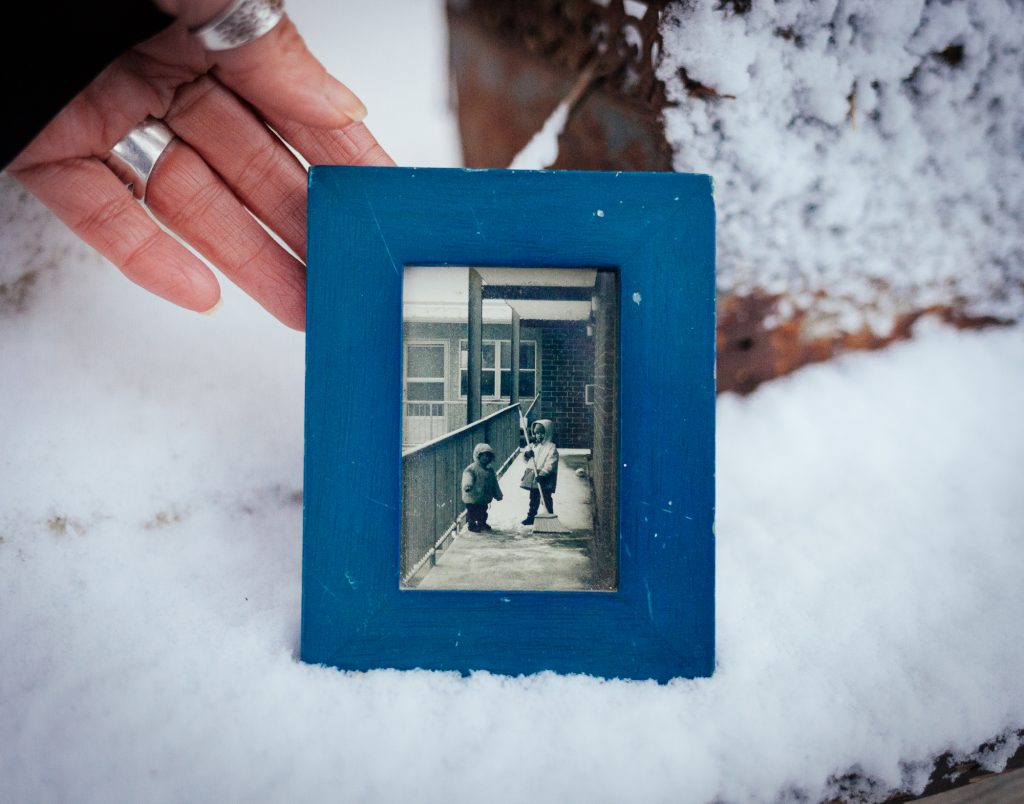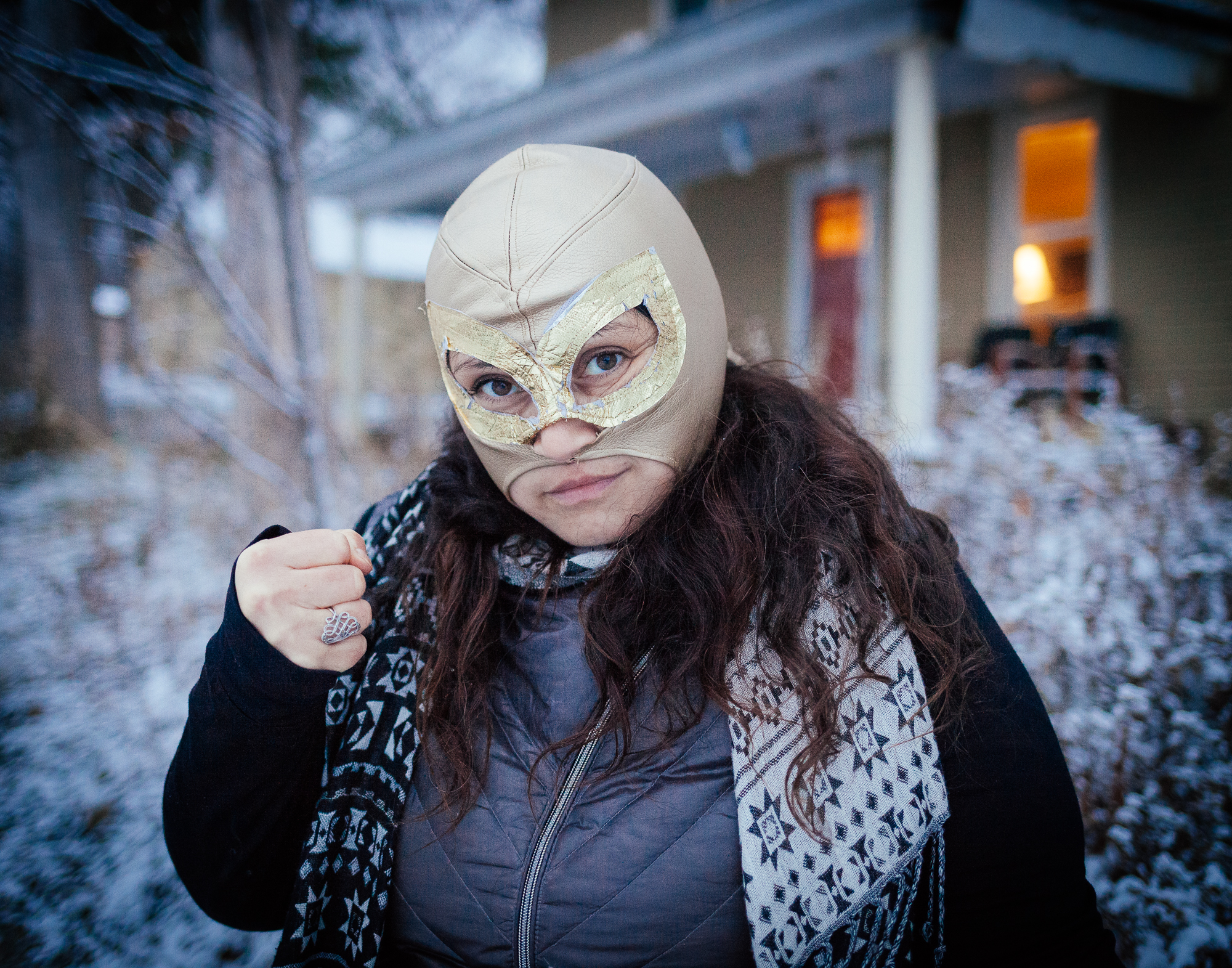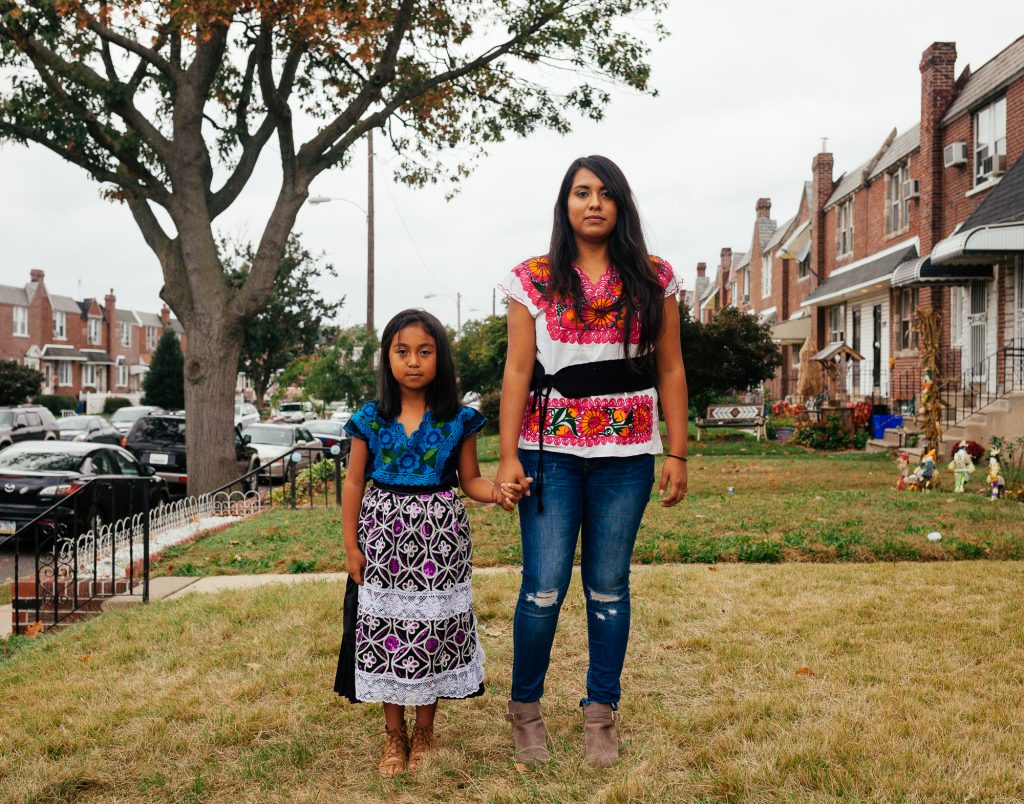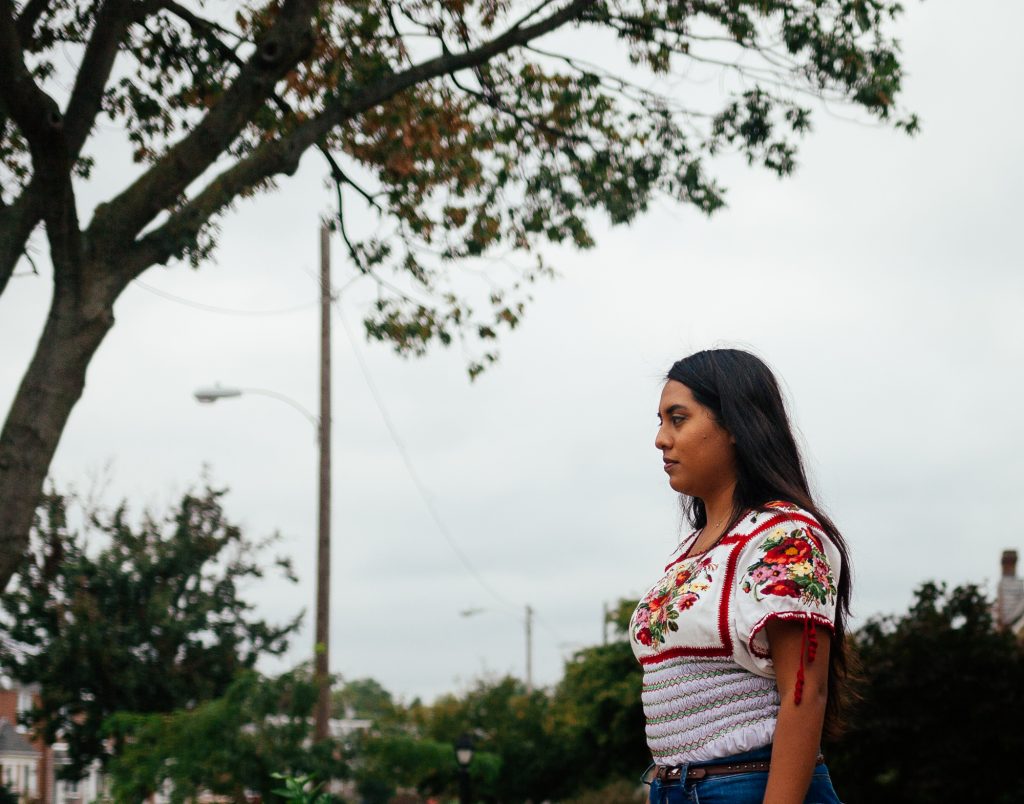
Tragic Beginning
Miriam’s father, an actor, died of colon cancer when she was six. It was a struggle for him to come to terms with his life ending, and his way of dealing with the pain was with violence.
“A lot of memories I have with my dad are really sad memories.” (audio below)

Miriam went with her aunt to get a black ribbon to tie on the store’s door – still not understanding that her dad was dead. When her older sister told her, Miriam didn’t cry; she felt free from the violence and relieved he was no longer in pain.
Miriam remembers seeing a document after his death that said she was an orphan.
“How could I be an orphan if I have a mom? Mexico’s culture is centered on the father figure – the male in the house – so it was very hard for my mom to be a widow and raise three girls.”
After her father’s death, if Miriam and her two sisters weren’t at school, they needed to work in the family store selling material for arts and crafts to support the family. Their only day off was Sunday.

Art as an Escape
The one blessing of working in the store was that Miriam had constant access to all the art materials she could dream of – art was her escape. Miriam is the middle child of the three sisters – her older sister was rebellious and her younger sister was “the sweet girl”. Miriam had to be the responsible one.
“I had to be strong and help my mom. At some point, I said, ‘okay, I’m going to be the man of the house.’”
If something broke Miriam would help fix it, or if someone was bullying her sisters, she would defend them. (audio below)

Her life growing up was not easy, and she remembers feeling like it would never improve. In 1985, when she was 15, she decided she was going to run away. Miriam had her things packed and was ready to run away. The day she was ready to leave, her older sister was gone – she had beat Miriam to it. Miriam’s mother was crying, and Miriam realized then, that she couldn’t leave too. (audio below)

Artist
Miriam always wanted to be an artist, but this was not something she felt her family or Mexican society in general supported. She remembers hearing how “artists are losers”. This didn’t make sense to Miriam though. The work of artists like Frida Kahlo, Diego Rivera, and David Alfaro Siqueiros is so important to her culture. She saw how artists were the people everyone remembers, even after they are gone.

In 1985, Mexico City suffered a massive earthquake – a significant moment in her teenage life. She recalls it being like a warzone with the entire downtown completely devastated. Miriam’s family had to move from their apartment to her aunt’s house. She felt compelled to document the scenes of devastation, but she didn’t have a camera. After that, Miriam decided she needed to get a camera. (audio below)
Miriam told her mom she was leaving to become an artist. She had a boyfriend, a journalist, who helped her get her first good camera. Miriam was gone for three years, but her life wasn’t heading in the right direction. She was getting into drugs and alcohol and had low self-esteem.
“I was letting myself follow a dream, swimming in a storm in the ocean, floating in the open sea.”
Spirituality
Miriam would describe her mom as a “seeker”, someone who is always looking for something. She has tried various different religions. When Miriam was 18, her mom called to say she had met her Guru in a dream. A woman dressed in red came, took her by the hand, and led Miriam’s mother to her spiritual teacher, a woman in India. Miriam’s mom felt that this dream really meant something and ended up going to an Ashram. When she saw Gurumayi, she recognized her as the Guru from that dream.
“Meeting Gurumayi was a 360-degree change for all of us”.

The whole family ended up connecting with Gurumayi, and after Miriam did, she started to meditate. She found this had a positive effect on her outlook and happiness. Miriam moved back in with her mom, kept studying, and managed to put the pain and sadness from the past behind her. Although this felt like a positive change in their lives, not everybody in conservative Mexican society viewed it that way.
“Meditating was like the devil. It’s not Catholic, so we became ‘the witches’. I didn’t care. Now I see schools teaching kids to meditate, but not back then. It’s very hard to follow a path that people don’t understand.”
University
When Miriam chose her major for university, biology, she felt like she was betraying her inner-artist. She tried to justify it by convincing herself that one day she would become a science photographer. By the time she was finishing her degree, she was already working as a scientist in Ensenada, Baja California in collaboration with NASA 1997 to 1998. She studied the productivity of micro-organisms in the Pacific Ocean through satellite imagery, but she didn’t like it, sitting there looking at a lot of numbers all day. She was doing the research in English, so everything took her extra long.

Miriam met the man who would become her husband when she was in high school, and he too was a scientist. Miriam’s daughter was born before the research in Baja California was finished, and then they all moved to Huatulco, a coastal tourist town in Oaxaca, where Miriam worked as an art teacher.

Iowa
Miriam’s goal was to attend grad school in either Australia or the USA. Her husband (now ex-husband) is a marine biologist whose main focus is on coral evolution. Iowa happens to be full of fossil corals. The next town over from Tiffin, where Miriam lives now, is actually called Coralville because thousands of years ago it was a sea and full of corals. Miriam knew nothing about Iowa before moving there.
“In my brain, it was like coming to Alaska. Everything is just white and ice and cold. In Mexico, we were living on the beach and it was beautiful. I love hot weather.”
Miriam and her two children, ages one and three, moved to Iowa City in 2002 to join her husband who had come the year before to start his Ph.D. They couldn’t afford to bring many suitcases – they left most of their things behind. Miriam was surprised that her husband didn’t have a place for them to stay. They arrived at one in the morning, and her husband was living in a shared house with other students. That first night they slept in the living room.
Luckily the university has a program for international families, and they eventually managed to get a place. Still, it was just an empty apartment with no furniture. Their kind Argentinian neighbor was excited Miriam could speak Spanish and showed her how to look for things in dumpsters that Americans threw away. Miriam found lots of stuff like a bed for her kids, a chair, and pots to cook. The neighbor also brought Miriam to the International Women’s Group – a meeting with other women who were in similar situations. These women showed Miriam kindness and even gave her a bunch of toys and warm winter jackets for her kids.

Struggling
For those first four years in Iowa, Miriam was just trying to make sure her family survived. Her husband was always working, so she needed to take care of everything at home. She also needed to work. She was not only trying to support her family in Iowa financially, but she was also trying to send money back to her mother in Mexico. Miriam remembers going for her first job interview, and her little son climbing all over the interviewer. Her first job was as a baker making muffins and scones from 3:30 until 8 am.
She heard about a scholarship that was available to the family of students already enrolled at the university, so she applied and got it. She was able to start studying at university pursuing a degree in photography and multimedia.
By the time her husband had almost finished his Ph.D. the kids were just starting elementary school. It seemed like he was concentrating so much at school, that he forgot about the family. When the kids wanted to spend time with him, he was always too busy. She will never forget the day she asked him for a hug, and he said “no”. She decided then and there that she would never beg for a hug again. (audio below)
Divorce
Miriam knew that she needed to think more about herself and her kids. She wanted to stay and finish her university degree, but her husband wanted to return to Mexico. She told him to go back without her and the kids. He left in 2005 and Miriam’s mom came from Mexico to help her. In 2006 her mom started getting sick. Miriam didn’t have insurance for her so she went back to Mexico and brought the children so they could visit their father. Miriam stayed in the US to finish her courses.
She thought her husband would get the children visas so they could travel back to the US to see her after three months, but he took his time. She had to wait seven months before she was able to see her children again.
“It was the most horrible time in my entire life. I cried every single day. I could not handle being without my kids.”
Finally, her children came back to Iowa, and Miriam’s daughter said she wanted to stay in the US and go to school. She wasn’t going to deny her seven-year-old daughter a better education. Miriam took on two jobs, looked after her children, and tried to study. Eventually, Miriam had to drop out of university and she was never able to finish her degree. Miriam found out about a school district with “before and after school”, so her kids could go to school when she was working. These sacrifices paid off. Both of her children did very well in school – her daughter was even the valedictorian.
“We came for school, stayed for school, and we are still here for school”.

Butterflies
Miriam has an art studio inside her house. Much of her work has an underlying message. Miriam’s current piece is of a butterfly and is dedicated to the “Dreamers” (those with DACA).
“For the butterfly, borders don’t matter. Butterflies belong to all of America from Mexico to Canada. I really hope people understand that, like the butterflies, it doesn’t really matter where you have to move – home is inside you, you know. It doesn’t matter where you are.”
She can’t understand why these young people, who have been in the US for most of their lives, have to struggle because of a piece of paper. She thinks it’s beautiful, like the butterfly, how so many of them overcome obstacles and are able to become successful professionals.

Lucha Libre
Miriam believes her late father always wanted a son. He loved watching sports like Lucha Libre, football, and boxing. He often treated Miriam like a boy, cutting her hair short, and reflecting on this now, she sees he was looking for a bond with a son. She really didn’t like Lucha Libre at first, but she would watch it with him, and he would tell her all the rules.
“I love Lucha Libre because it combines a lot of things. It’s like a circus. They have to be great athletes but also it’s theater and the spectators are part of the show. The luchadores feed on the energy from the spectators.”
The wrestling mask, known as the mascara, is an essential part of Lucha Libre. For many luchadores, their careers end when their mask comes off.
“The mascara is a symbol of the entire culture. It includes everyone. There are women luchadores, little people, people who are gay, people of all different ages, and the spectators are from the lower-income to the very rich, all in the same space screaming for their favorite luchador.” (audio below)

No Longer Invisible
Miriam noticed the Latino community in Iowa is “completely invisible”. A lot of cultural events, specifically within the arts, are too expensive for many Latino families in the area. She wanted to elevate their voices. Since 2017 Miriam has been trying to document Latinos in Iowa for her project Luchadores Immigrants in Iowa. She began doing interviews and photographs, but everyone told her they didn’t want to show their face. Miriam came up with the idea of a project where the participants can hide their true identities by wearing a custom-designed mascara, and still share their migration story.
Miriam didn’t realize how emotional and personal doing this project would become. She tries to balance connecting with the participants’ stories, while not letting them get to her so personally that they crush her heart. She has witnessed the diversity of immigration stories within Iowa’s Latino community – and many stories that make her feel privileged.
Creativity

Miriam’s son has always appreciated and benefited from, his mom’s creativity. He would always ask his mom to make outlandish Halloween costumes, and no matter what it was Miriam would make it. In tenth grade, he requested the Radish Spirit from Haya Miyazaki’s “Spirited Away” and within one day Miriam delivered [see the above photo]. (audio below)

Tragedy
One of the toughest moments in Miriam’s life was when her little sister, the “sweet one” [see the photo above], died in October 2018 at age 47. She died from the same thing that killed their father – colon cancer. Miriam has found it incredibly painful being separated from family during times like this but feels fortunate to have been able to video chat with her sister before she passed away.
“Life comes with death. You can’t have one without the other one and you never know when it is going to be your turn.”
Future
Miriam works on her art when she is not at her day job at the local grocery co-op. She would love to one day be a full-time artist. She would also love to return to Mexico, and one day create a non-profit in Oaxaca that helps women and children, but she loves Iowa.
“I’ve found so many beautiful people in Iowa who have helped me in so many ways.”
Miriam stayed in America for her children. Their needs have always come first. Her daughter is at university and planning on going to grad school and her son is finishing high school and planning on going to university. Miriam couldn’t be prouder.
Hope
Seeing people reject immigrants breaks Miriam’s heart. She has heard their stories and wants others to see the humanity in them. Miriam emphasizes that with climate change, this movement of people in search of safety isn’t going to stop.
“I really hope all countries realize that we are one, independent of what country we are born in. Borders don’t really exist – they are there to organize. When you have to leave everything behind to have a better chance, you are going to take the chance despite all the odds. You find people in your path who will make that path easier, and more welcoming. We need to realize that all we have is this planet and we have to share it. It’s not for one person, it is for everyone.” (audio below)
#FINDINGAMERICAN
To receive updates on the book release and exhibition of “Finding American: Stories of Immigration from all 50 States” please subscribe here. This project is a labor of love and passion. If you would like to support its continuation, it would be greatly appreciated!
© Photos and text by Colin Boyd Shafer | Edited by Kate Kamo McHugh. Quotes edited for clarity and brevity.























